Watching Film With... Leonard Williams

LOS ANGELES — Altogether, I watched approximately 1,000 hours of football last season. Roughly 20 minutes of that was dedicated to the college game.
For years my interest lay exclusively with the pros, which is why I felt like a hobo with no railcar as USC’s associate SID, Paul Goldberg, used a fingerprint touchpad to get me through the glass doors of the John McKay Center, home of the Trojans’ football offices. Up a winding ivory-tiled staircase is the main lobby, affixed with trophies, game balls and assorted red and gold memorabilia. Hallways feature movie poster-sized photos of recent USC greats, some in Trojans uniform (Troy Polamalu), others in current NFL duds (Carson Palmer). Something about the environment—perhaps all the natural light—makes a visitor feel both welcome and privileged to be there.
Down the hallway on the left are small classrooms. It’s here where I will meet with junior defensive lineman Leonard Williams. A few days earlier, I added several hours on top of my 20-minute college football quota by dissecting each of Williams’ snaps from USC’s September 6 victory at Stanford. And hours before our meeting, I watched Williams, a projected top-five pick, gyrate around an auxiliary field for more than 100 NFL scouts, coaches and front-office executives during USC’s pro day. Many have described the 6-5, 302-pounder as an “athletic freak.” With only spandex between him and thin air, that reputation was furthered.
Immediately following the workout was his mini media tour. Over the course of six interviews, Williams said exactly what a projected draft pick is supposed to say: nothing of substance, but stated eloquently. Ninety minutes later we are in the classroom, ready to talk real football. He perks up when he walks in and sees “all-22” coaches film projected on the wall.
Photo by Jed Jacobsohn/SI

Williams takes a seat alongside me in front of a computer monitor that doubles as a telestrator. I tell him there are a lot of “athletic freaks” in the NFL, but the ones who prosper are those who also have a grasp of football knowledge and fundamentals. I’m here today to get a feel for Williams’ football IQ.
Unwarranted self-satisfaction flickers through me when Williams says that the Stanford game film is what many NFL teams had him analyze during 15-minute combine meetings. That figures; Stanford’s was the best offensive line Williams faced. It was also his most productive outing. I later found out he wasn’t even expected to play because of an ankle injury suffered in practice that week.
More Prospects
Brandon Scherff: The draft's best—and nastiest—blocker is a modern-day Paul Bunyan.Marcus Mariota: The Oregon QB's game is being scrutinized more than anyone's.


Williams was meaningfully involved in roughly 20 of the Trojan defense’s 68 plays. In no sequential order, we go through about a dozen of them. The first is a takedown of scrambling QB Kevin Hogan, which came off a two-man stunt improvised by Williams and edge rusher J.R. Tavai.
As Williams breaks down the play, it’s immediately apparent that he has a capacity not just for understanding the intricacies of football but also for explaining them. He can even articulate his instincts. His description of the stunt draws heavily on the football lexicon; if put into a textbook, almost half of the words would be bolded and defined in the back.
I have visions of readers closing browsers, their heads spinning a hundred miles an hour. Grateful to be the one running the clicker, I rewind the play and restate much of what Williams spewed out, only in layman’s terms. Williams catches on and slows his delivery from there on out.
But he doesn’t dumb things down too much, which is good. He softly elaborates on every play, liberally applying the word “sir” when answering questions. He politely refutes any thoughts he disagrees with. And, if necessary, he corrects me in a way that engenders a continued open dialogue.
Much of what we review in this film session reaffirms why many believe Williams is indeed the best defensive lineman in this draft. See for yourself.
• WATCH: The full film session with Leonard Williams.
The Natural
Williams: Our rusher to the boundary [short side of the field] is coming to blitz. We actually called a “natural,” which is not actually in the game plan. Me and No. 58 called it out, and he basically told me that the tackle was sitting really back on him so I was trying to take the guard upfield and penetrate, and 58 was going to loop around me take the A gap right here.
Benoit: So your job was to occupy both blockers and create a path for him, and the path is created there, the coverage takes it away and it’s a second effort at this point.
Williams: Yeah.
Watching Film With... Leonard Williams
a1.jpg

a2.jpg

a3.jpg

Low Man Wins
Benoit: You get off the block and force the redirection. What’s the technique? To people who haven’t played, this looks like a bunch of big bodies running into each other.
Williams: Yeah, that is kind of what it looks like, but what we’ve been taught for the last three years is… I forgot what he’s called it, some type of crab walk or something like that, but you try to get as low as possible, on your hands and feet. And you know low man wins in football. It’s all about leverage, so as soon as you see that snap you just get off the ball. We try to stay low, and once we get off the ball and make contact then you try to rise through the man.

Crossing Face
Williams: The main reason why I would say it’s a win is because I took up two blockers and still was able to cross face. What I mean by “cross face” is: I play a 4-technique [lined up over the offensive tackle] so we read the lineman right, and if he steps out like that I’m supposed to read him and follow with him. And once I see that the ball was trying to cross around him and they were trying to cut me off, I was trying to cross over No. 78. So it actually freed up some of the linebackers because 57 tripped up trying to pull around him. So 78 is supposed to reach me and 57 is supposed to pull around and go up to the linebacker.
Watching Film With... Leonard Williams
c1.jpg

c2.jpg

c3.jpg

Rare Ability
Benoit: This play is why they are talking about you as a high draft pick. This looks like a simple play—in some respects it might be—but explain: Is this just an instinct thing how you move left and right like that so well? There aren’t a lot of guys your size who shed a low block and then seamlessly transition going down the line of scrimmage. This is athleticism and technique.
Williams: Yes sir. I’m glad you said that because it definitely takes a lot of technique. You know there are a lot of guys who are talented plus athletic, but it takes being in the film room and being on the practice field, going over it all the time. We knew Stanford cut block so we went over this drill a thousand times in practice. I was able to do it without thinking. Once I actually see it happen I just react.
Watching Film With... Leonard Williams
d1.jpg
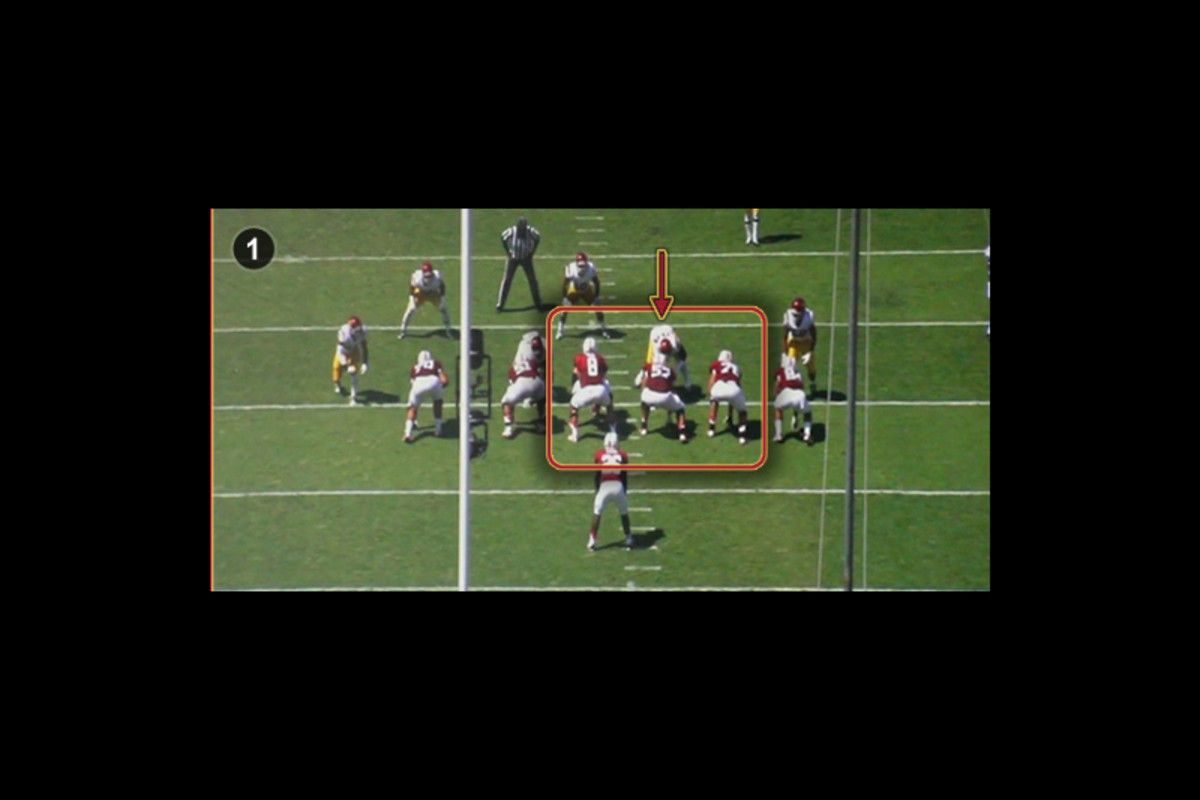
d2.jpg
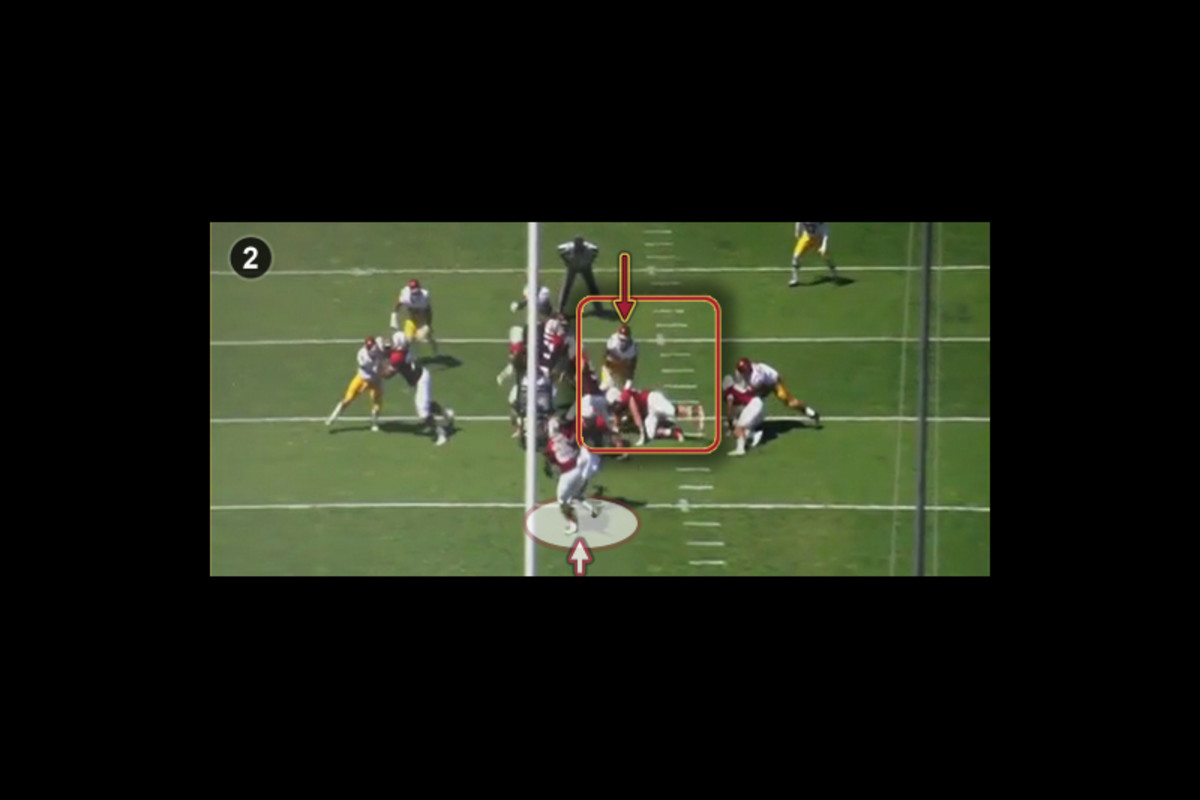
d3.jpg

The ‘J.J. Watt Thing’
Benoit: Another cut-block play that fascinated me—this is another one that looks very simple. What I found interesting on this play was how quickly [you got your hands up]. This is the whole J.J. Watt thing: If you’re not going to get home you’re taught to put your hands up take away the passing lane, bat it down. This is what has made Watt, among other things, a lot of money. It will get you paid in the NFL. Let’s look at how quickly you come off this snap and immediately sense that it’s a three-step [drop]. You’re not even pass-rushing at that point. I thought perhaps it was because you saw the cut block here. Oftentimes with a cut block it’s a three-step timing because they are trying to cut the defender’s legs and make him come down [and out of the passing lane]. But you were already sensing this [before the cut block], it looked like. Can you tell me why you knew this play was coming?
Williams: I sensed it was because when I’m pass-rushing, usually they don’t back up that far. You see how [the blockers] are backing up immediately? This team specifically, when they pass block, they try to quick-set you. So I realized that they were backing up so it was going to be a quick three step-drop for the quarterback. So I just tried to get my hands up.
Benoit: In pass protection, blockers normally drop back. In a “quick set” they step into you initially to engage. The Bears and Saints have done it a lot.
Williams: It’s to try to catch you off guard when you’re getting a takeoff to get to the quarterback.
Watching Film With... Leonard Williams
e1.jpg
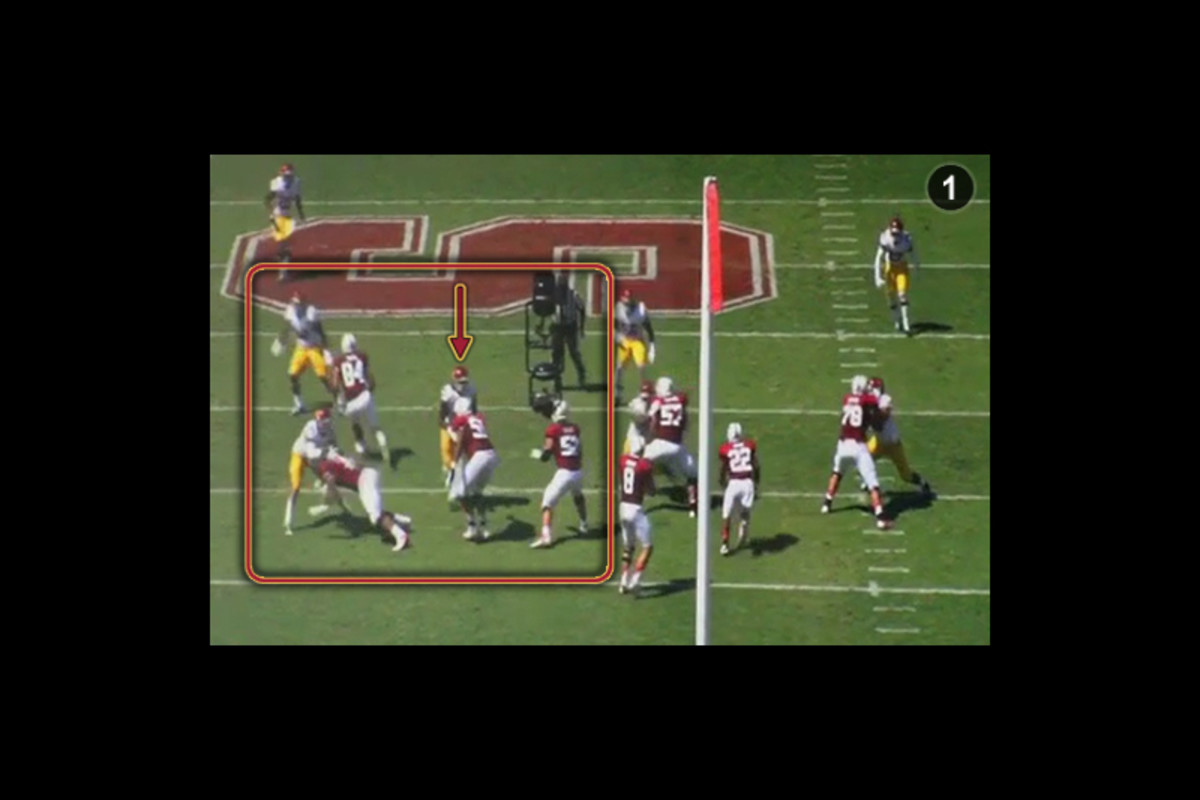
e2.jpg
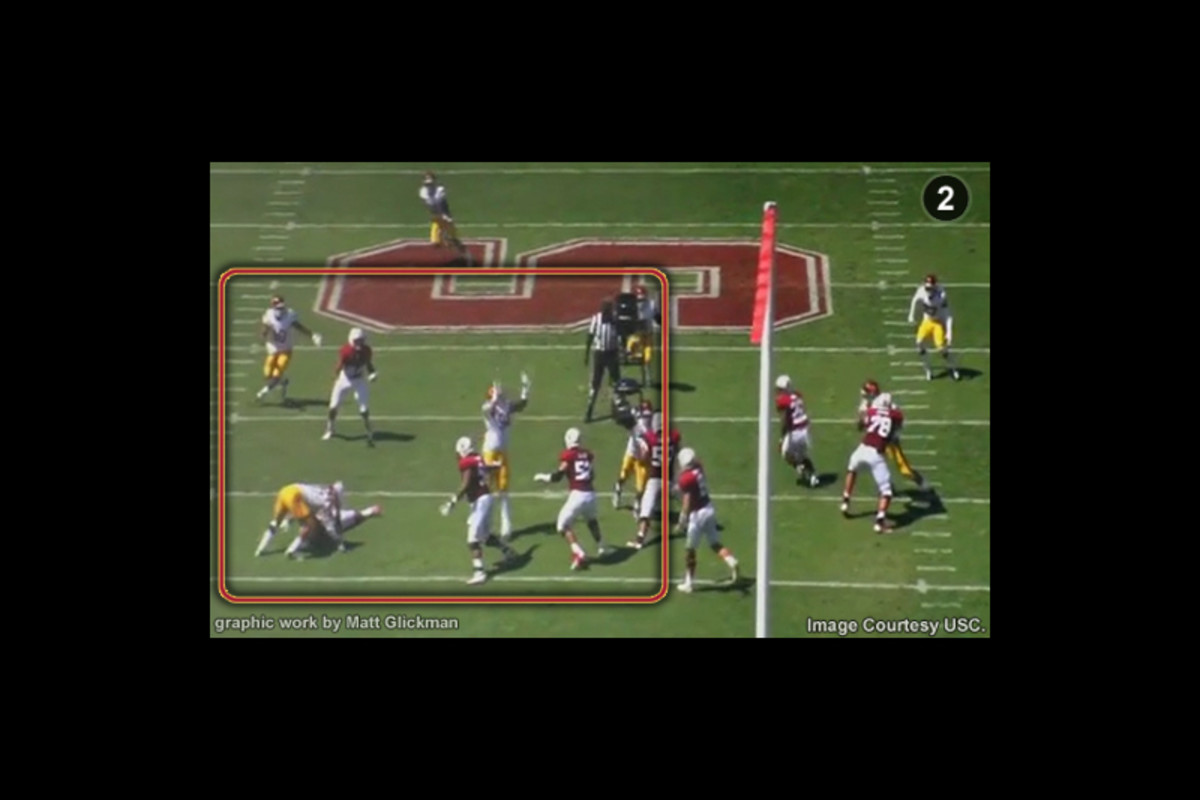
Caught Cheating
Benoit: This is Andrus Peat, another guy who’s having his pro days and getting a look in the NFL. Talk about what’s happening on this play.
Williams: He captured my outside shoulder. I cheated on the inside a little bit, I’m typically straight head-up, but I was on the inside of his shoulder on that one. As you can see I’m on his inside.
Benoit: So you’re supposed to be helmet-to-helmet with him?
Williams: But sometimes our coach allows us to cheat our linemen if we think the play is coming towards us. I thought this was just going to be a regular power formation, and I thought the ball was going to come inside. So I tried to cheat a little bit on the inside. But they actually went outside of me so it actually helped that the tackle captured my shoulder, made it easy.
Watching Film With... Leonard Williams
f1.jpg
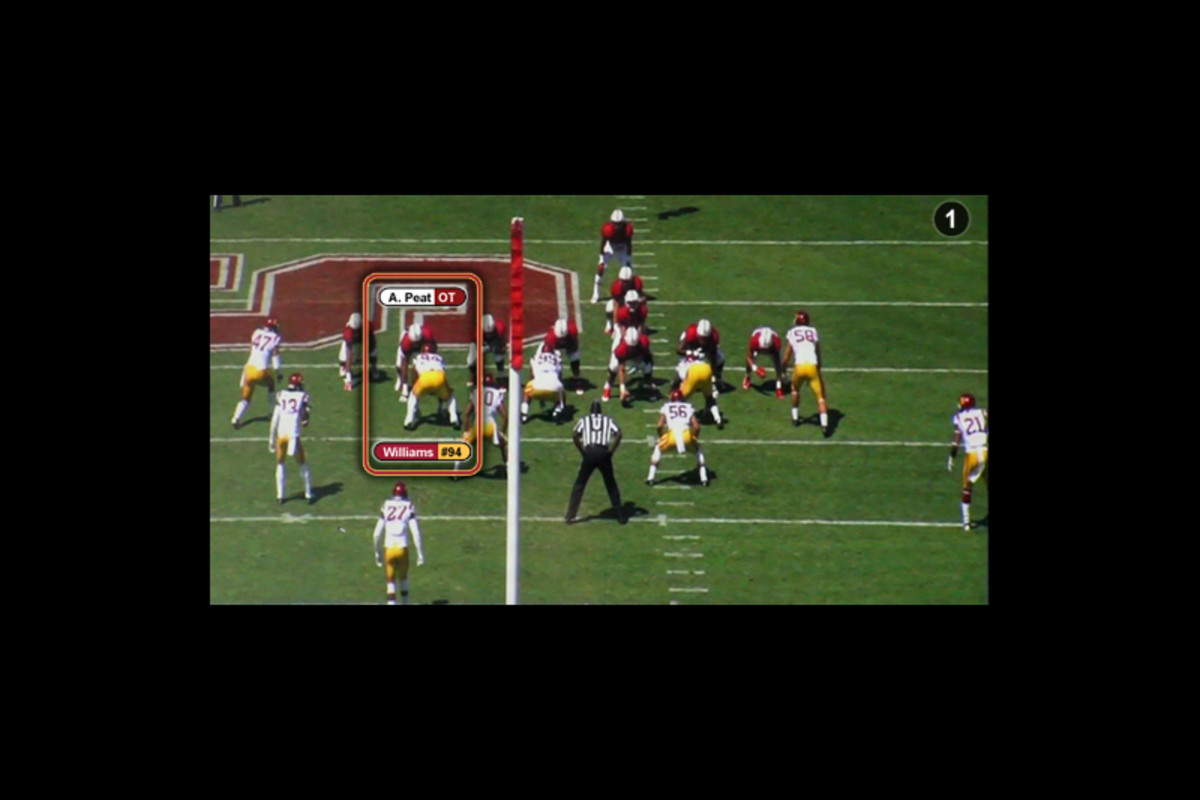
f2.jpg

f3.jpg
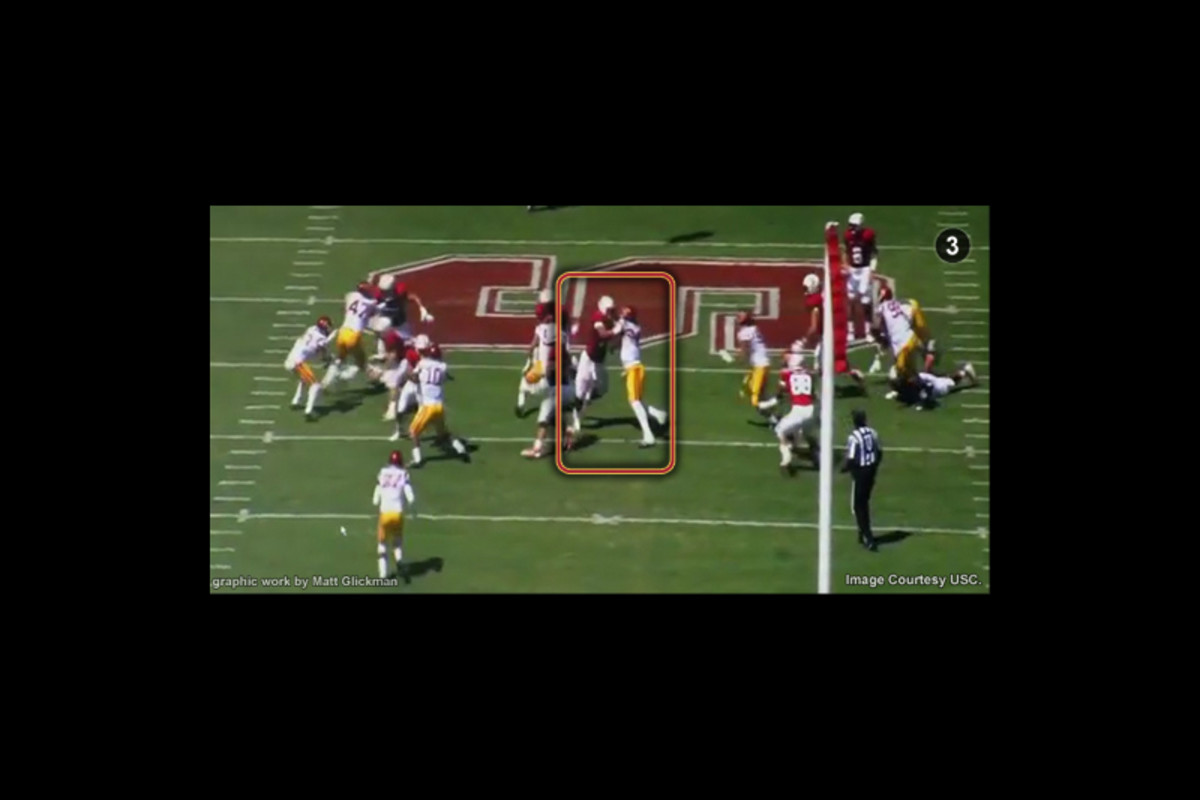
Scrape Over the Top
Williams: This was just reaction, basically. I think the tight end that No. 58 was on fell down. So you see the big pile right there? My inside gap was taken away by that big pile. So I just scraped over the top once I saw that.
My primary gap is actually [inside], but since I see the guard pull and that big pile happened, I knew to scrape over the top because the running back was going to [go outside].
Watching Film With... Leonard Williams
g1.jpg

g2.jpg

g3.jpg
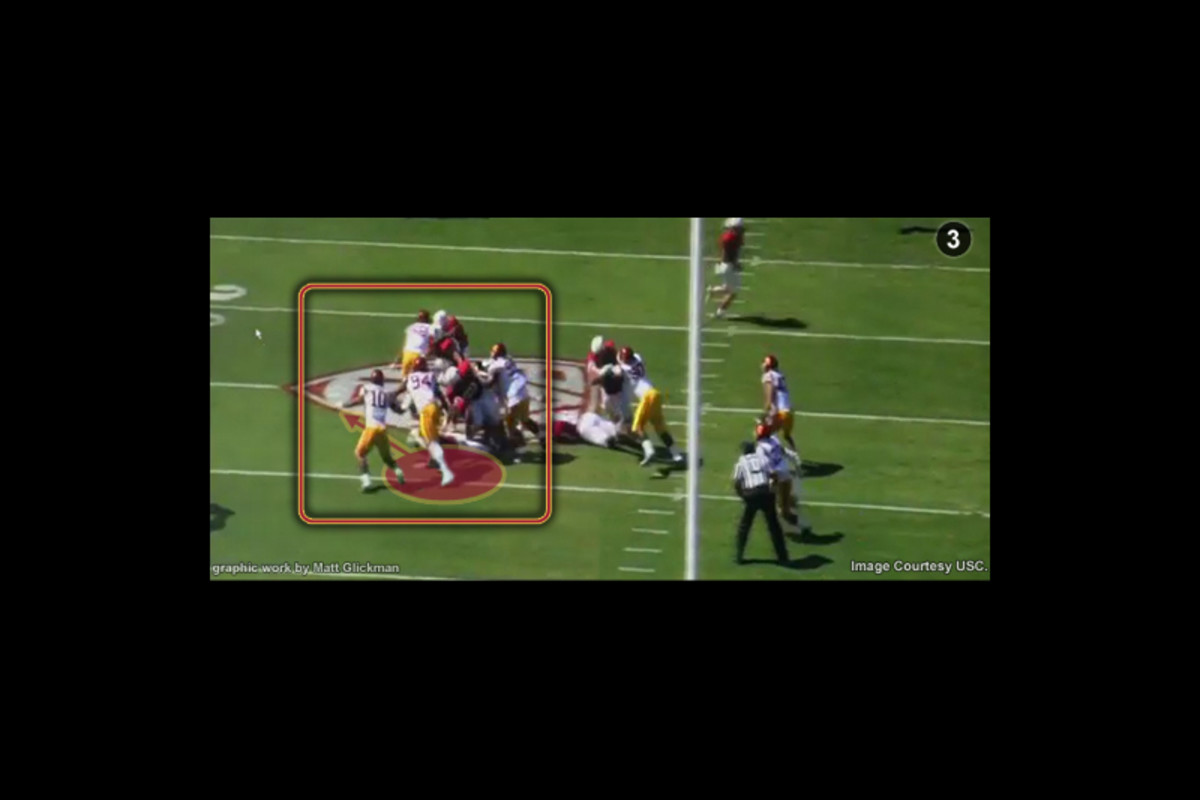
More than a Freak
Benoit: This is a counter run. My guess is that you read the pulling guard here, but I want you to confirm this.
Williams: Yeah, I was reading the guard. Once I see him pull around, I knew the center was going to crash down to me. So the guard pulls around, the center comes to me. My job is to cross over the center and follow the guard.
Benoit: And you sense this, I’m guessing, because the guard’s initial step off the snap is one little hitch backwards—is that what tells you? Or did you sense it before that?
Williams: I kind of knew it before this to be honest. Just watching film I noticed that he puts a lot of tension on that foot he’s leaning on.
Benoit: His left foot here?
Williams: Yes. He leans on that foot. I could tell immediately he was going to pull so I crashed down to the center right away.
Benoit: That’s great stuff because this has nothing to do with being a “freak of nature.” This is being a football player.
Watching Film With... Leonard Williams
h1.jpg
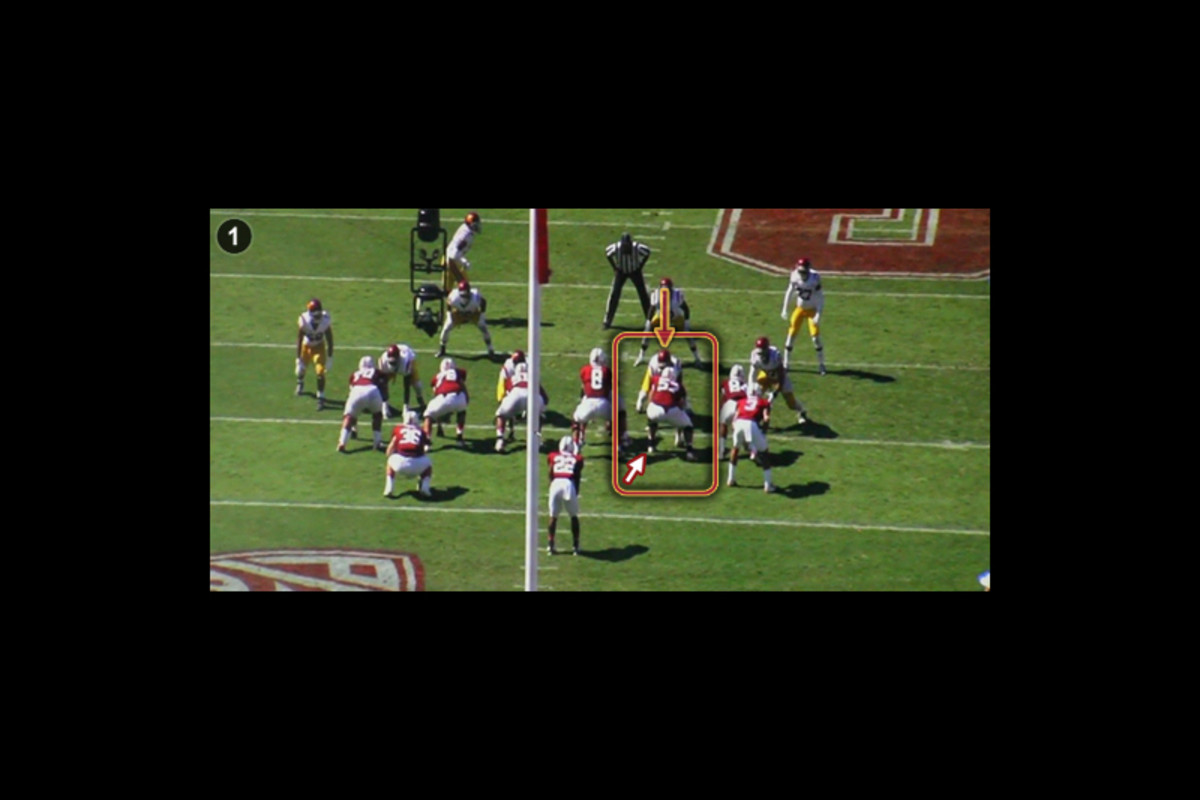
h2.jpg

h3.jpg

The Biggest Play of the Game
Benoit: Let’s end on the biggest play of the game. You can probably guess which one we’re going to here. This one maybe does have a “freak of nature” factor to it. To set the stage: there’s about a minute to go. It’s second-and-3. They’ve been knifing you down the field for about six or seven plays by now. You’re probably hot, you’re probably a little bit tired, late in a September game. They’re in field-goal range, down by three, in position to tie and looking like they’re going to go ahead and win. You’re lined up over the guard. Take us through the play.
Williams: Like you said, it was the end of the game, they were on their way to coming back. We basically just knew that we needed to make some type of plays, whether it’s sacks or strips, get the ball back or something like that. We tried to keep them out of there. I realized this was a pass protection because the offensive tackles had their hands on their knees instead of in the dirt. From that point I’m just try to react to whoever moves first, whether it’s the O-lineman or the ball. Get-off is the biggest part of a pass rush. They tried to chip me with the back. and I just spun off of his chip and went to the other side.
Benoit: At this point in the game, was there an extra “oomph” in your pass rush? You say you’ve got to step up, you’ve got to make a play and all that kind of stuff. I imagine in the second quarter, it’s third-and-5 and you rush the passer off a nickel d-align, you’re going hard, you’re going all out. But is your all-out in the second quarter different than your all-out at the end of the game right here? Do you find a different gear you didn’t know was there, or how does that work?
Williams: I would say there is a different gear because in the second quarter it’s still a long game. I’m still going to give it my all like you said but when it comes down to a tight game like this against a rival team, it comes down to big players making big-time plays in big-time games and stuff like that. So it always goes in my head when we’re playing big games—when it comes close like that I just try to put the team on my back and just try to make some plays.
Benoit: Now the politically correct answer to this question is “I’m prepared to play every position, whatever they ask me to do.” What’s your best position, though, for the NFL?
Williams: I think what I do best, I have a lot of versatility. I’m able to play 3-technique if they need me to head up, or 5-technique, but I would prefer probably 3-technique in just attack mode. I’m able to get off the ball faster that way and get to the quarterback.
Watching Film With... Leonard Williams
i1.jpg

i2.jpg

i3.jpg
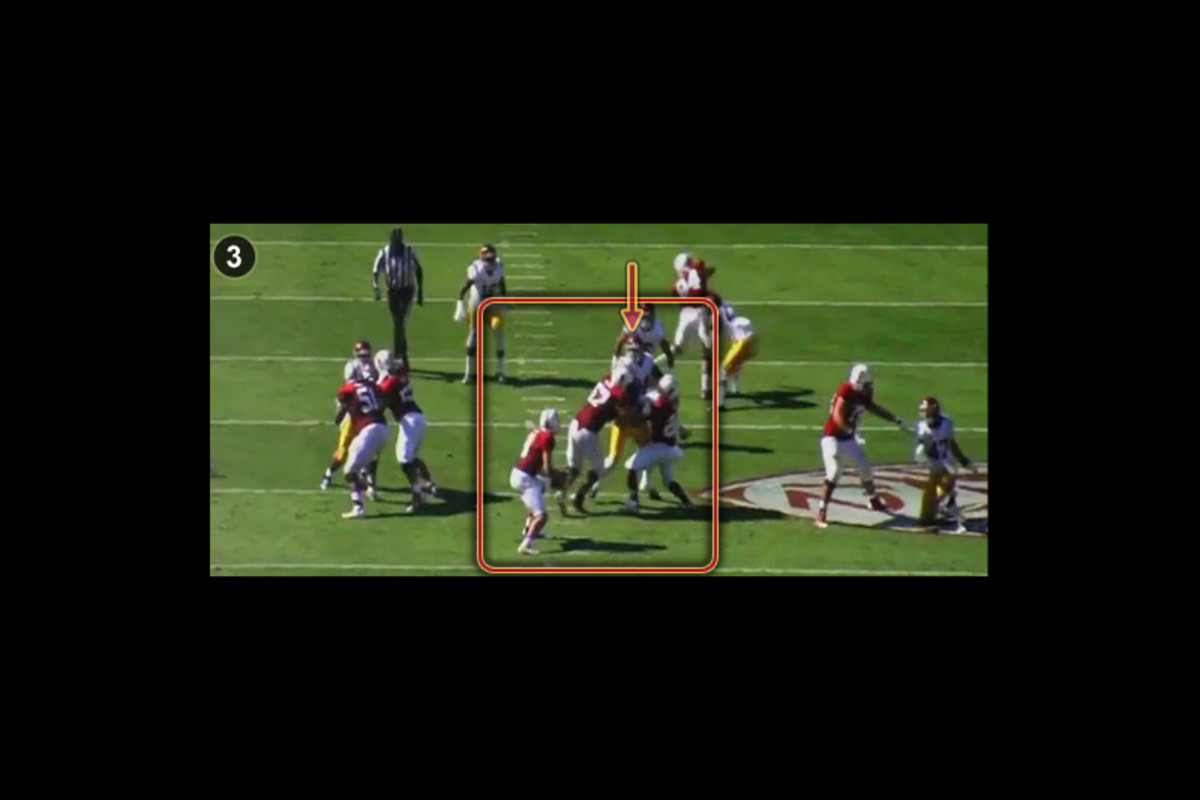
i4.jpg

* * *
More Prospects
T.J. Clemmings: A switch from defense to offensive tackle awakened a monster.Shaq Thompson: Before he was an NFL prospect, he was baseball's worst player.


The film session leaves me with a much better impression of Williams. I’m inexperienced analyzing college athletes and projecting them to the NFL, but from the small examination of Williams’ film I didn’t quite see him as the athletic freak I’d been told to expect. Sure, there are glimmers of that, but what will make Williams successful in the NFL is his capacity for employing fundamentals. He has the tools to build on this as a pro. Williams tends to play tall, which is often a good way to get blocked. But Richard Seymour played tall, and it’s a combination of power and movement skills that has kindled comparisons between the two. Seymour, who deserves serious Hall of Fame consideration, had more raw power and unusually long arms, allowing him to get away with playing upright. Williams will have to play lower.
After the film session, I do a quick interview with Williams. Sitting directly across from him, I get a true appreciation for his size. He engulfs his chair, blocking out the light behind him and leaving me heartbreakingly aware of my skinny arms. He maintains eye contact throughout the questions and even during the downtime—of which there’s more than expected while the camera crew rearranges equipment. As the delay wears on, awkwardness threatens to set in. Williams fidgets a bit. Suddenly, it’s easy to remember that he’s only 20.
After the cameras mercifully start rolling again, we wrap up with some of the obligatory questions—the ones Williams undoubtedly answered throughout his earlier whirlwind of interviews. He remains patient and thoughtful through the end, which he punctuates with a handshake that’s both soft and firm, like what you’d imagine a bear’s to be if it had opposable thumbs.
With that, Williams is ushered out of the room. He has one more interview to cap a long day. Tomorrow it’s back to his full-time job: football.
Follow The MMQB on Facebook, Twitter and Instagram.
[widget widget_name="SI Newsletter Widget”]

